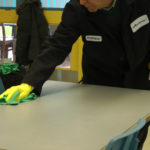 Let’s assume the following scenario. It’s the middle of a cold, nasty winter and the Centers for Disease Control and Prevention (CDC) has reported a significant upswing in the number of children coming down with colds, the flu, and different viruses. They suggest that all facilities – schools, park and recreation centers, etc. – that are used by children take extra precautions and use EPA-registered disinfectants in all restrooms and common areas used by staff and children. *
Let’s assume the following scenario. It’s the middle of a cold, nasty winter and the Centers for Disease Control and Prevention (CDC) has reported a significant upswing in the number of children coming down with colds, the flu, and different viruses. They suggest that all facilities – schools, park and recreation centers, etc. – that are used by children take extra precautions and use EPA-registered disinfectants in all restrooms and common areas used by staff and children. *
This information is conveyed to all park managers who direct their cleaning staff to step up their use of disinfectants. However, even with these stepped-up efforts, children in the park district are still coming down with a variety of illnesses similar to those reported by the CDC. Your job as park manager is to find out what could be causing this unhealthy situation to escalate when procedures have been put in place intended to de-escalate the situation.
Unfortunately, there is not one specific way to determine the cause. There may be a variety of causes but typically when working with disinfectants, they come down to the following:
• Improper dilution of the disinfectant
• Using the wrong disinfectant
• Improper disinfect application
• What is now referred to as “quat binding.”
We will address each of these below.
Selecting the Right Disinfectant and Diluting It Properly
The easiest problem to correct is selecting the right disinfectant, so we might as well start here. Earlier we referred to using an “EPA-registered” disinfectant. This refers to a disinfectant, or as referred to in the professional cleaning industry, an antimicrobial product, that has been tested and proven to be effective against specific germs and bacteria while also meeting certain environmental standards. If it meets these criteria, the disinfectant is registered by the Environmental Protection Agency and it will bear a registration number on the product label.
For our purposes now, the key words in this definition are “effective against specific germs and bacteria.” Not all disinfectants are designed to kill all pathogens. Most are effective against specific types of germs. While one disinfectant may prove effective at helping to stop the spread of MRSA, or kill salmonella, E. coli, or other bacteria and viruses found on surfaces, the same product may not be effective when used to kill norovirus, or the germs and viruses that cause influenza, hepatitis A and B, measles, etc.
For this reason, administrators must always check the labels of the disinfectants they select. A janitorial distributor can be very helpful in this endeavor. But what happens if you are not sure what pathogens are present? Fortunately, we have “broad spectrum” disinfectants that are designed to kill some of the most common pathogens in a facility.
As to our second issue, proper dilution, a very wise and inexpensive investment park managers should consider is an auto-dilution system. These systems properly dilute the cleaning solutions per the manufacturer’s recommendations. Primarily, this helps avoid waste of the product but it also ensures that the correct amount of disinfectant is used when cleaning.
By the way, more is not better when it comes to disinfectants and most cleaning solutions. More chemical means more chemical residue will be left on surfaces, which can actually attract soils and pathogens.
Improper Disinfectant Application
A very common reason that disinfectants fail to work effectively is the fact that many cleaning professionals do not realize that working with disinfectants is always a two-step process. First, the surface must be cleaned using an all-purpose cleaner or something similar. This first task is to remove the source, the pathogens, soils, bacteria, that might be present on a surface.
The second step is to clean the same areas now using the disinfectant. This two-step process can be avoided if the product being used is labeled as a “cleaner disinfectant,” but many are not so the two-step process is necessary.
Next, read the label and look for something that indicates the “bacteria kill time.” The words “dwell time” may also be used. With some disinfectants, this may be as little as three minutes. For others, it could be as much as ten minutes. What the label is telling us is how much time it takes this disinfectant to be effective at eradicating the germs and bacteria on a surface. Also, cleaning professionals should know that the disinfectant must remain wet. If the disinfectant dries on the surface, it should be reapplied and the process repeated.
Quat Binding
If you have never heard the term “quat binding” before, join the club. It is actually relatively new to the professional cleaning industry as well. Quat refers to quaternary ammonium chloride, an active ingredient found in most EPA-registered disinfectants. The phenomenon of quat binding refers to the absorption of quaternary ammonium chloride into the cleaning cloth being used or, if mopping floors, into the mop head. As this happens, the disinfectant loses its effectiveness.
Looking at this situation a bit more carefully, what it is believed is happening is the quats are positively charged and many cleaning cloths and mop heads are manufactured with natural textiles such as cotton, which are negatively charged. This causes the quats to be absorbed into the cotton.
In one study, the quat level of a disinfectant on a cleaning cloth was reduced by 50 percent after soaking for ten minutes. This means that the pathogen killing benefits of the disinfectant have been cut in half.
There are different ways to prevent this. Among them are the following:
• Apply the disinfectant directly to the surface to be cleaned and allow it ample time to work effectively.
• Frequently change the cleaning cloth or mop head (and the mop water as well) used for cleaning and disinfecting.
• Avoid using standard terry cloth towels with disinfectants; microfiber is more effective at removing soils from surfaces and will not be as impacted by quat binding.
Another option is to look into other cleaning systems. While they are not designed specifically to kill germs and bacteria, what are known as aqueous ozone cleaning systems and no-touch cleaning systems will not be impacted by quat binding because no textiles are used in the cleaning process. They can also address some of the other disinfecting challenges mentioned earlier.
Finally, managers and cleaning professionals should start using ATP monitoring systems. These devices are essentially an electronic petri dish. A surface is swabbed and the swab is then put into the device, which looks like a television remote control. In about 15 seconds, it indicates if ATP is present on a surface. While it does not indicate specifically what types of pathogens are on a surface, a higher-than-usual ATP reading should always be viewed as a red flag, indicting cleaning and disinfecting are necessary.
Ron Segura, formerly Manager of Janitorial/Document Services for Walt Disney Pictures and Television, is a cleaning consultant working with corporate campuses, schools and universities. He can be reached through his company website at https://www.seguraassociates.com.

